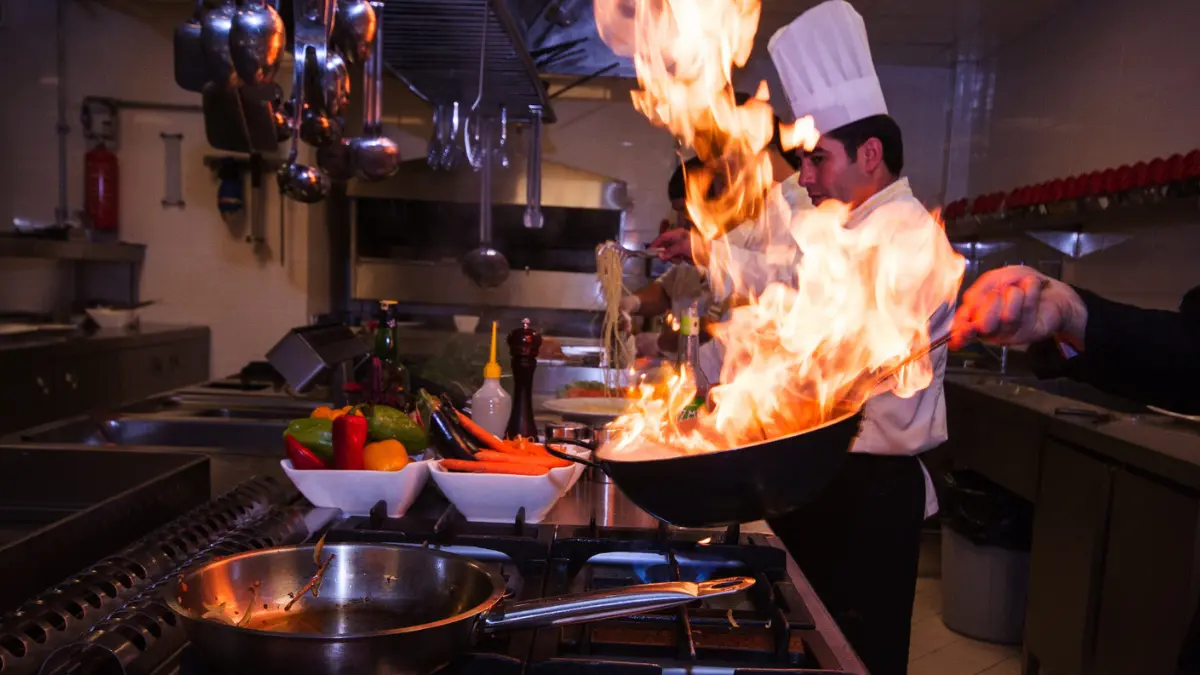Investing in equipment is one of the main startup costs of a restaurant business. By identifying your restaurant business model, budget, consideration of space, and other related aspects, you can identify the essential restaurant equipment that you need to invest in.
In this blog, we are going to cover everything you need to know about restaurant equipment
We are going to discuss:
- Things to consider before buying restaurant equipment
- New restaurant equipment trends
- Types of equipment and its details
- Where to place
- How to maintain your equipment
- Where to buy restaurant equipment
- Financing (types of loans, price of equipment)
Things to consider before buying
So what exactly mean to restaurant equipment?
Restaurant equipment can be tools, appliances, and other devices used in a restaurant to store, prepare, cook, and serve food.
However, this is 2023, and the food industry has undergone so many innovative changes. Technology plays an important role in the industry.
Now we have types of equipment that are innovative to simplify and speed up your work. It helps you to reduce the manpower that needs to do work and cut costs.
To invest in the right equipment you need to consider the following points.
Budget
Budget is one of the important aspects when planning to purchase equipment for your restaurant. Because you have to spend your budget to invest in equipment.
If you are limited by budget and don’t have much space in your restaurant, then you can find equipment that can meet your multiple needs.
For example, a combi oven can be used for doing multiple tasks. That can function as a steamer, convection oven, and microwave, making it a great all-in-one solution for cooking and reheating a variety of dishes.
So you don’t want to separately buy different types of equipment for your different works.
If you purchase equipment on an installment basis you have to calculate the interest rate and maintenance cost. If you can meet the price, then it is fair to purchase.
However, it matters to consider your budget before investing in equipment.
The size of your restaurant
The size of the restaurant that you are going to purchase should be considered. Most restaurant equipment is physically big, so consider the space that you have in your restaurant.
If you don’t have enough space in your restaurant, find alternatives for that equipment. Or invest in tools that can be used for multiple tasks.
Make sure you have enough space in your kitchen and dining area. Therefore, the employees can work without any rush, and also provide a better customer experience.
Type of your cuisine
Different types of cooking require different tools. Consider the menu items you will be serving and select appropriate equipment for the cuisine you serve.
The type of restaurant you operate may be determined by several factors.
Menu: The menu is the main factor that makes your restaurant unique. If you are focused on precisely one type of cuisine, such as Italian or Mexican.
However, you need to purchase kitchen equipment that can be cooked your menu items.
Atmosphere: The atmosphere of your restaurant can also help you determine its type. For example, a restaurant with a casual atmosphere and simple, affordable menu will likely be classified as a diner or cafe. A more formal restaurant with a more upscale menu and decor is likely to be classified as a fine dining establishment.
If you are focusing and intending to bring a specific type of atmosphere, then you can invest in your interiors, such as furniture, and food serving utensils.
Service style: The service style of your restaurant can also help you determine its type. For example, a restaurant with table service and a more formal atmosphere are likely to be classified as a full-service restaurant. A restaurant with counter service and a more casual atmosphere are likely to be classified as a fast casual or quick service restaurant.
So a food truck may not need the equipment that is used in a full-service restaurant.
Target audience: Consider the target audience of your restaurant. Are you mainly serving families, business professionals, or college students? This can help you determine the type of restaurant you are running
However, identifying your restaurant type will help you to invest in the right equipment.
Quality
Most of your equipment is purchased for the long term. So you have to check the quality of the equipment and make sure it can last for the long term. We would like to share some tips to check the quality of equipment.
Purchase from the authorized brand: Make sure you are purchasing equipment from an authorized brand that provides quality material and construction.
If it is service-based like software make sure that they provide quality service. Also, make sure they are trustful and they can secure your business data.
Certifications: Look for equipment that has been certified. This ensures that the equipment meets certain standards for safety and cleanliness
Inspect equipment: Check the structure of the equipment and make sure it is well made (make sure it will last). Pay attention to things like welds, screws, and other possible weak points.
Test before purchasing: Before purchasing make sure it can meet your needs. Also, if you are purchasing from an offline store check the working conditions and make sure everything is well.
Reviews: Gather reviews from online resources. Listen to the opinion of others about specified equipment. It will give you a better understanding of each piece of equipment. It can also detect potential damage to equipment.
Material checking: Make sure the equipment is made with high-quality materials, such as stainless steel or heavy-duty plastic. Good materials can last too long and are easy to maintain like cleaning.
Investing in quality equipment may cost more money, but it can last for years.
Brand reputation
Purchasing restaurant equipment from reputed brands can help ensure that you are getting a high-quality product that is backed by good warranties and customer support, and that will hold its value over time.
There are several reasons you need to purchase from reputed brands
Quality: The reputed brands will focus on build quality and it will be last
Warranty: the reputed brand will offer a long-term warranty on their products. It gives protection from manufacturing defects.
Service: Reputed brands usually have better service networks in place, which can be helpful in case you need repairs or maintenance for your equipment.
Resale value: The reputed branded equipment holds its value better. So it will be more profitable for you when selling it.
Maintenance
Maintenance is an important consideration when choosing restaurant equipment because it influences the performance, efficiency, and lifespan of the equipment.
Equipment that requires regular maintenance can disrupt a restaurant’s operations and can be costly if regular maintenance or replacement is required. Therefore, it is important to choose equipment that is low-maintenance and easy to maintain, to minimize downtime and reduce maintenance costs.
Some factors to consider when evaluating equipment maintenance needs include frequency of use, the complexity of equipment, and the availability of replacement parts.
However, it is better to choose products that are easy to maintain and have readily available parts if repairs are needed. Maintenance costs should also be considered and make sure you can afford them.
Energy efficiency
Energy efficiency is a really important one when choosing restaurant equipment. There are several reasons why you need to consider energy saving.
Cost savings: Energy-efficient equipment can help to reduce energy costs by using less electricity or gas. This can result in significant savings for a restaurant over time.
Environmental impact: Energy-efficient equipment can also help to reduce a restaurant’s carbon footprint and contribute to a more sustainable operation.
Government incentives: In some areas, there may be government incentives available for businesses that use energy-efficient equipment. These incentives can help offset the upfront cost of purchasing the equipment.
Customer perception: Choosing energy-efficient equipment can also help a restaurant appeal to customers who are environmentally conscious and may be more likely to dine at a restaurant that is making an effort to reduce its impact on the environment.
Overall, considering energy efficiency when choosing restaurant equipment can help to reduce costs, reduce the environmental impact, and enhance the restaurant’s reputation with customers.
User-friendliness
It is important to consider the user-friendliness of the equipment because it can impact the efficiency and productivity of your staff. Equipment that is difficult to use or requires a lot of training can lead to delays and frustration for employees, which can impact the overall operation of the restaurant.
On the other hand, equipment that is easy to use and intuitive can help to streamline processes and improve the efficiency of your staff.
When you buy service-based equipment like a KIOSK, you need to ensure that it is manageable and user-friendly for your employees and customers.
Additionally, user-friendly equipment may be preferred by employees, which can lead to increased job satisfaction and increased turnover.
However, choosing user-friendly equipment can help improve your staff’s efficiency and productivity and enhance the restaurant’s overall operation.
Shipping and delivery
Shipping and delivery mean transporting equipment from your supplier to your restaurant. This could involve using the supplier’s delivery service or contracting a third-party shipping firm, like a freight carrier. When selecting restaurant equipment, it’s crucial to take into account the supplier’s shipping and delivery alternatives, as well as the associated costs and schedule
However, it is essential to ensure that your delivery equipment is safely packaged, and insured and that all legal procedures are met.
Technology
Technology is very important when buying equipment for business. It plays an important role in the restaurant business. It simplifies many tasks. Buying equipment requires you to make sure that you are investing in advanced equipment.
Since then the equipment is a long-term investment, the equipment should be useful for a long time as the business changes.
New restaurant equipment trends
It is very important that you buy the current trending equipment. It will help you to simplify your tasks and reduce operational costs. Here are some equipment trends to watch for in the restaurant Industry.
Multi-functional equipment
Restaurants are looking for equipment that can perform multiple tasks, such as combination ovens and combi-steamers that can bake, roast, and steam food.
Automating tasks
By automating various restaurant tasks you can simplify your business operations. Investing in equipment like POS systems enables a new level of guest experience and business efficiency.
POS with inventory management can automate your inventory and keep your inventory efficient. The system can track your inventory, and notify you even if the food ingredients go out of stock.
You can reduce your labor cost and enhance customer experience by using the Kiosk system. So the customer can order food and pay through the kiosk without any assistance from employees. You don’t have to buy dedicated kiosk hardware for that, you can use your tablet as a kiosk system.
However, investing in equipment that can automate your business tasks will be more beneficial.
Changes in equipment designs
There are a lot of changes are getting in restaurant equipment design. It becoming more and more user-friendly, space-saving designs, Sustainable designs that are environmentally friendly, and building with advanced features such as touch screens and voice control.
Types of equipment
Here is the list of equipment that you need to invest in for your restaurant business.
Cooking equipment:
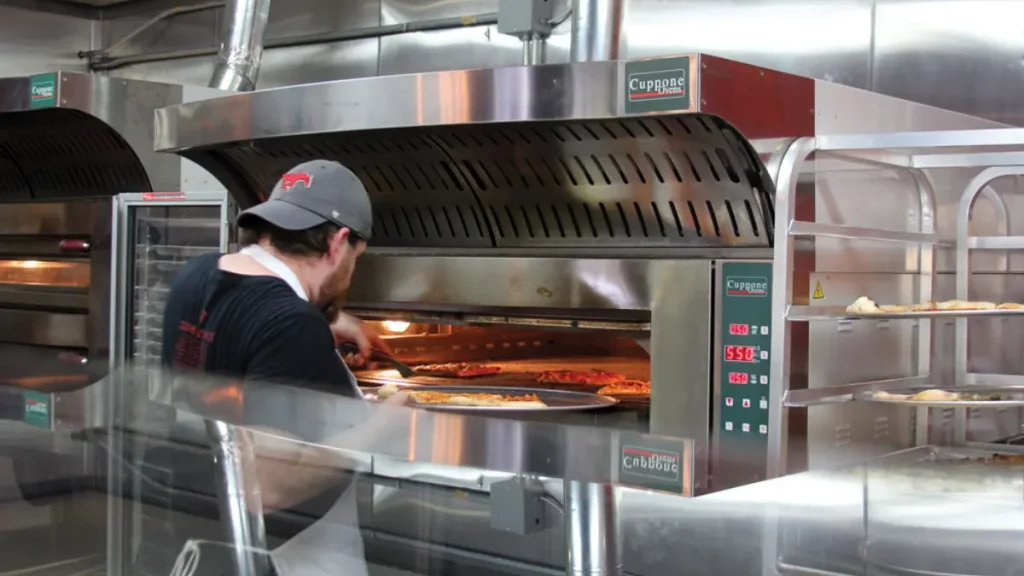
Cooking equipment means various equipment used in the preparation of food in a commercial kitchen. It includes Ovens, stoves, grills, fryers, and other appliances used for cooking, roasting, grilling, and frying food. Some important cooking equipment is given below
1. Ovens
This equipment is used to roast, bake and boil foods. ovens can be electric, or gas. it can be used to cook different types of dishes, including bread, pastries, meats, vegetables, and more.
One of the main advantages of ovens is that they can cook large quantities and different types of dishes at once. To make cooking simpler and more effective, some ovens also contain features like self-cleaning cycles, digital controls, and precise temperature adjustments.
Types of ovens
- Convection ovens:
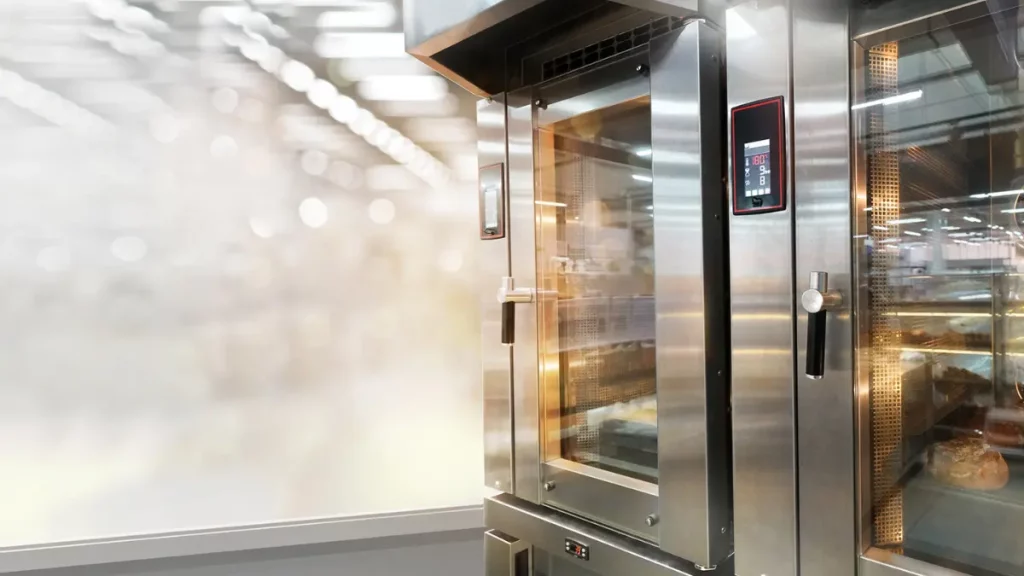
These are ovens that use fans to circulate hot air, allowing food to cook more evenly and quickly. Increased air circulation helps to cook food faster. The convection ovens are mostly used by bakeries and they are mainly used to boil, bake and roast a wide variety of dishes.
- Combi ovens:
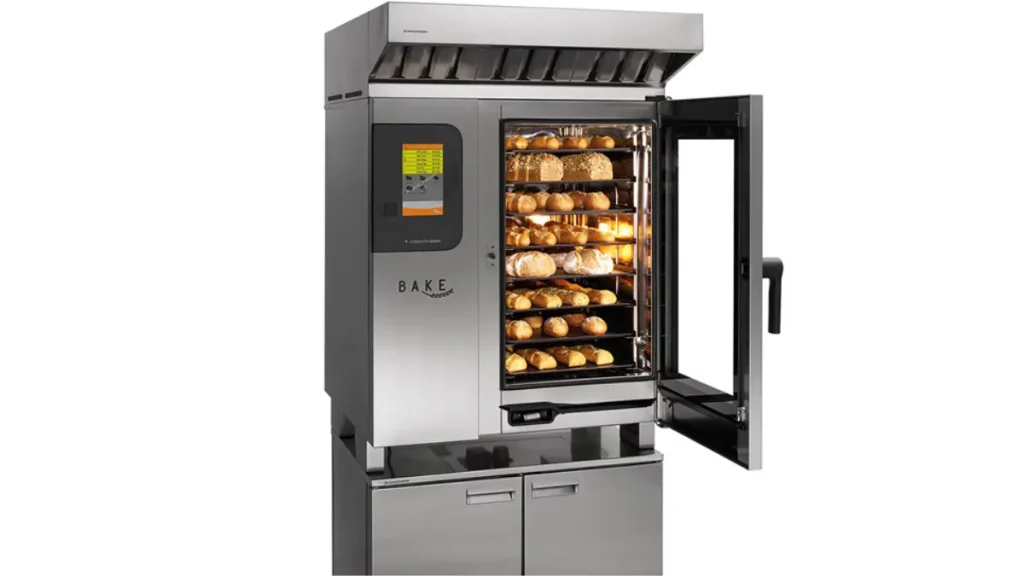
They are used in restaurants due to their versatility and ability to cook a variety of dishes. You can use it to cook hot air, steam, or a combination of both.
- Wood-fired ovens:
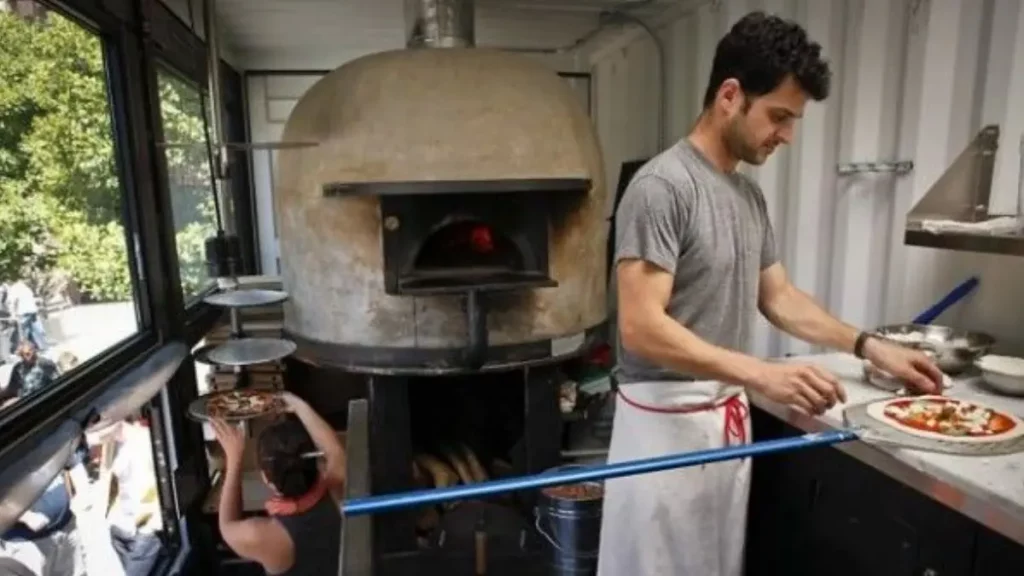
Also known as wood ovens. These are ovens that use wood as fuel sources and are often used to cook pizzas and other dishes with a wood-fired flavor.
- Gas ovens:
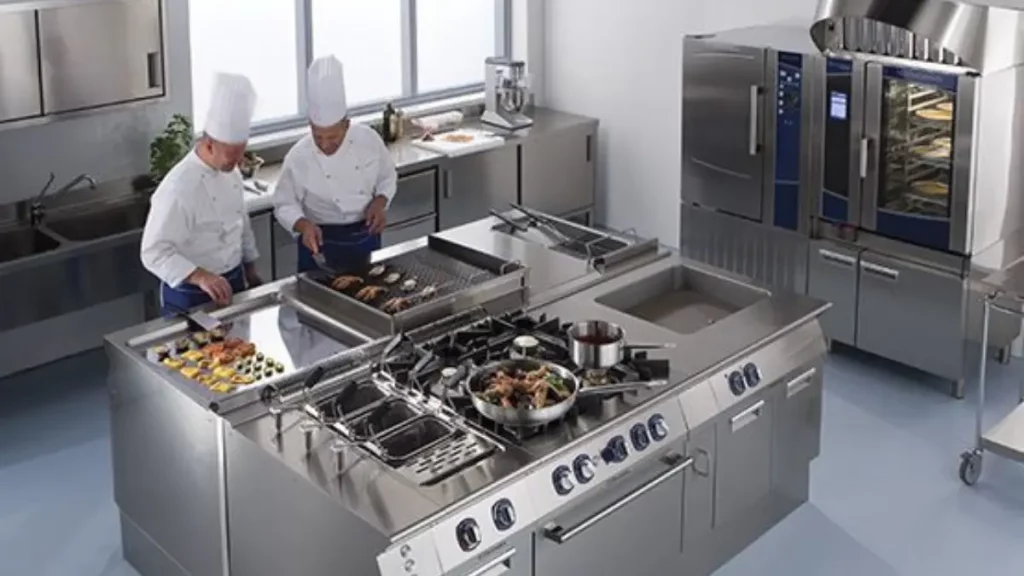
These are ovens that use gas as their fuel source and can be used to bake, roast, and broil a wide variety of dishes.
- Electric ovens:

These are ovens that use electricity as their fuel source.
- Conveyor ovens:
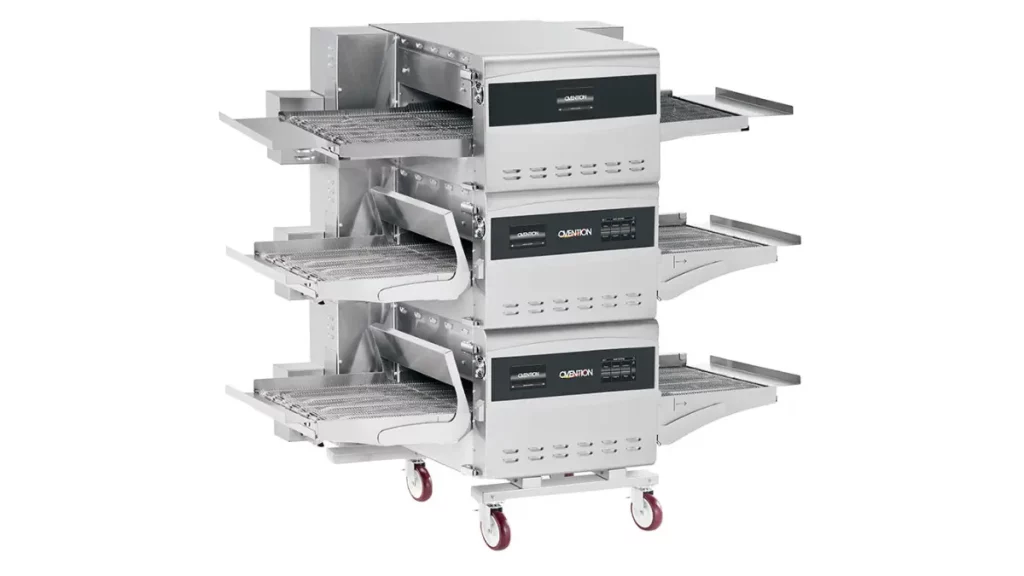
This type of oven is available in gas and electric. A conveyor is used to transport the material through the oven. As the cooking dish passes through the conveyor, it receives heat from the top and bottom.
Where you should place your oven
Placing your oven depends on various factors such as your restaurant layout design, the space of your kitchen, your working area, and more. Here are a few things to consider when placing ovens in your restaurant.
- Accessibility: Make sure the oven can be easily accessible by chefs and your other staff. This will allow them to prepare food quickly and more efficiently.
- Ventilation: Make sure you have good ventilation in your restaurant. Especially the area where you are going to place your oven. Good ventilation will help you to prevent heat and smoke.
- Space: The space of the kitchen should is considered in your restaurant before placing the oven. Make sure you provide enough space for employees to work comfortably.
- Flow: Visualize the flow of your kitchen and figure out where the oven fits in your layout.
However, it is more convenient to place the oven in your center to the rest of the kitchen.
2. Stoves
A stove is a type of cooking appliance. It is used to cook food on a flat cooking surface, usually made of metal or ceramic, often with pots and pans. It consists of a heating element, such as gas burners or electric heating elements.
Types of stoves
- Gas stoves:
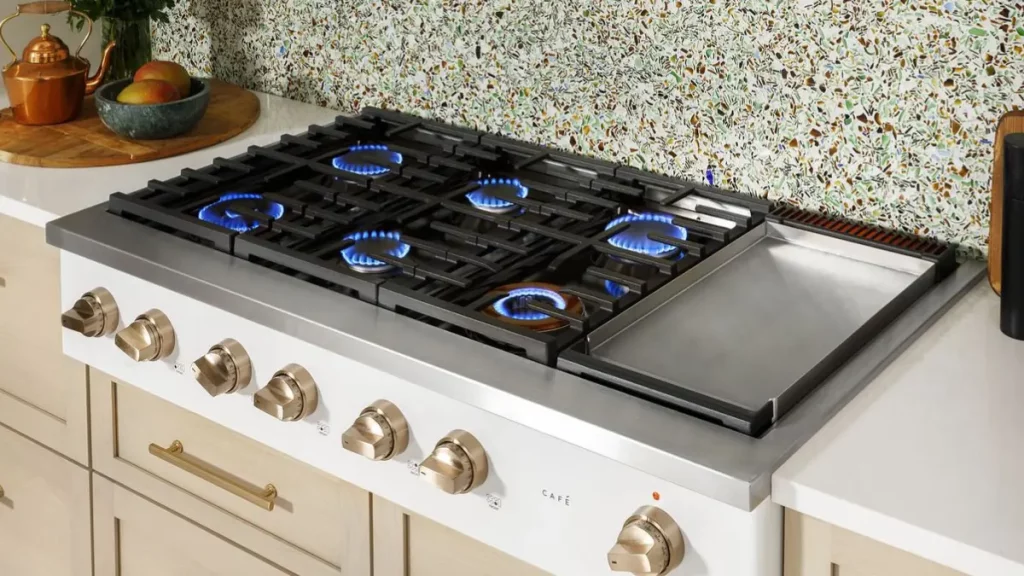
These stoves use natural gas, syngas, butane, propane, liquefied petroleum gas, or other flammable gas as fuel sources and have burners on the top cooking surface.
- Electric stoves:
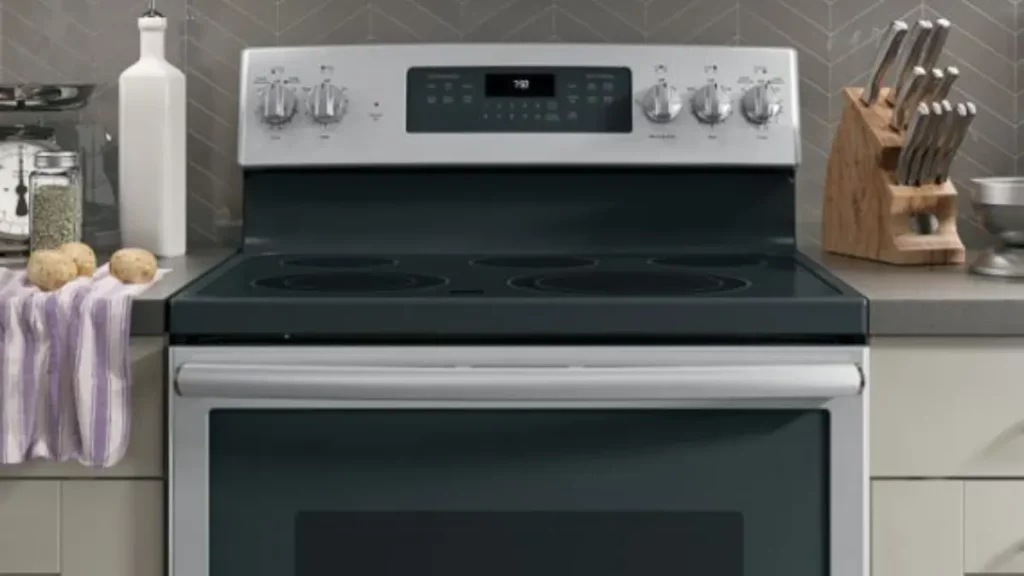
Electric stoves are generally more energy-efficient than gas stoves. When compared with Gas stoves Electric stoves will take time to heat up. These types of stoves are using electricity to heat the cooking surface equipped with heating elements that can be on and off.
- Induction stoves:
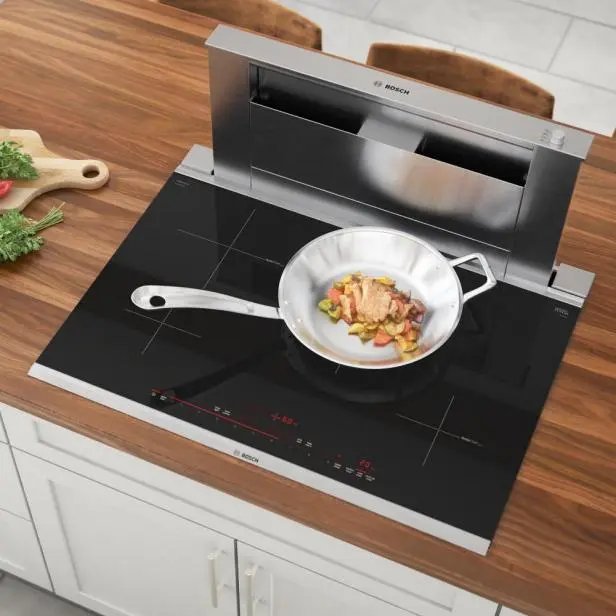
These stoves contain electromagnetic that can generate heat and which can transfer to the pot on the cooking surface.
- Wood-fired stoves:
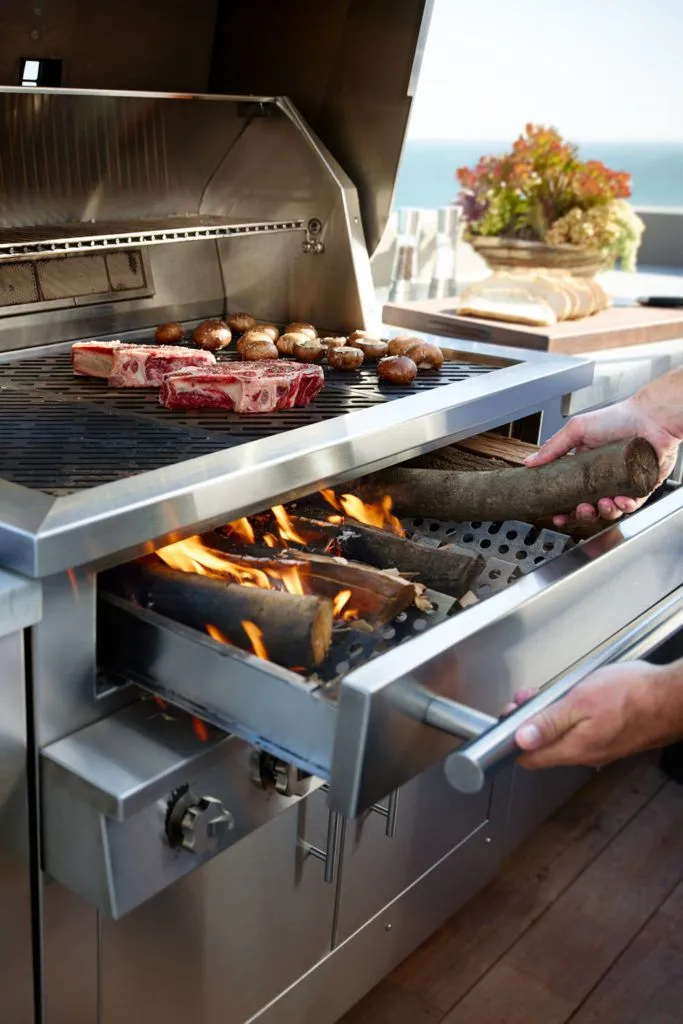
Wood-fired stoves use wood as fuel. So many restaurants use it to bring a traditional touch to their menu.
- Flat-top griddles:
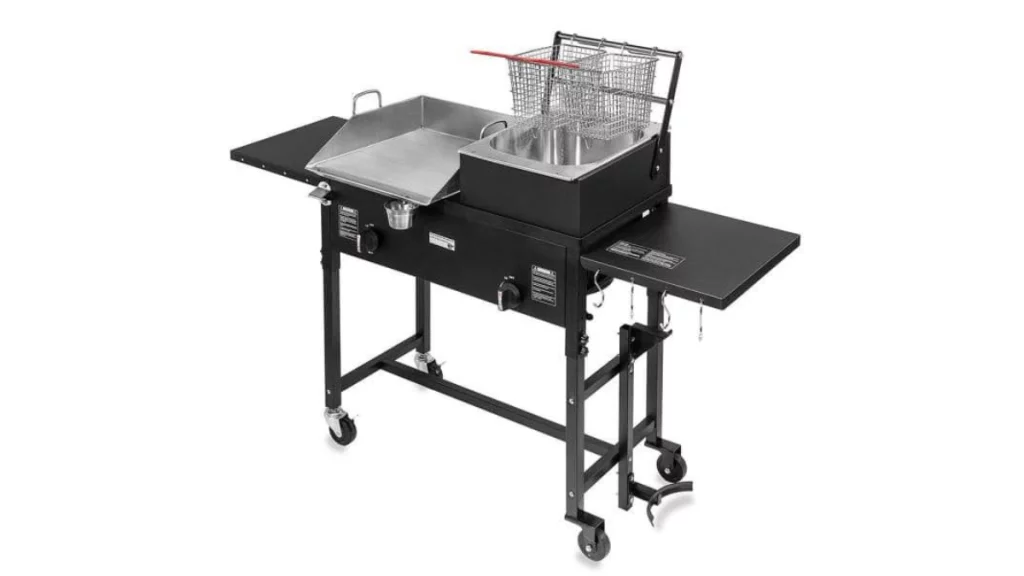
Flat-top griddles are commonly used in commercial kitchens. it is a cooking surface that is flat and smooth, usually made of metal, and designed for cooking a variety of foods, such as pancakes, burgers, eggs, and vegetables.
The best place to place your stoves
A stove is one of the most frequently used appliances in a restaurant kitchen. So it should be more convenient to use and place in the best accessible area. If the stove is placed in the center of the kitchen it will be more accessible to your chefs.
Visualize the layout of your kitchen, and how the workflow will be more functional, then you will have an idea of where to place your stoves and ovens.
3. Fryers
The fryer is equipment that can be used to deep frying of food. It consists of a heating element, a basket to hold the food, and a container to hold the hot oil.
Fryers are commonly used by restaurants to cook a variety of food such as french fries, fish, chicken, and donuts.
Types of fryers
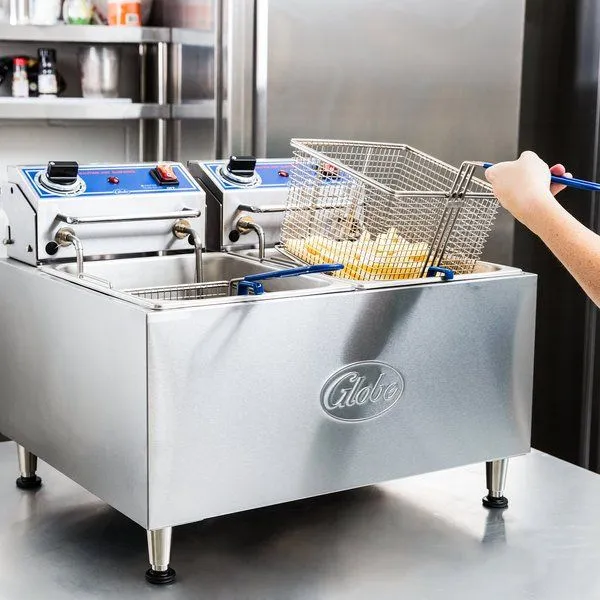
There are several types of fryers used by restaurants
Electric fryers: It is more energy efficient when compared to gas fryers. These fryers use electric heating elements to heat the oil.
Gas fryers: Gas fryers use fuel as natural gas or propane to heat the oil. It can heat faster when compared to electric fryers.
Countertop fryers: It is a small fryer that can be placed on the countertop and is typically used for small-batch frying.
Floor fryers: Floor fryers are used to fry high volumes of food. It is commonly used by fast-food restaurants to prepare foods such as chicken, french fries, fish, and doughnuts. Floor fryers run on gas or electricity and come in a variety of sizes.
Floor fryers can contain large amounts of oil to fry food that may have multiple fry baskets to accommodate different types of food. It allows you to cook a lot of food at the same time.
Pressure fryers: Pressure fryers are a type of equipment used in restaurants to fry foods quickly and efficiently. They work by combining hot oil and high pressure to cook food, resulting in a crisp exterior and moist interior. It is energy efficient, quick to cooking, and safe to use.
Where you can place fryers
Fryers need more free space in your kitchen fryers like floor fryers are larger equipment. Before planning your kitchen layout you have to consider the equipment that you are going to place in your restaurant.
Consider this when you are going to place your fryers in your kitchen
- Make sure you are going to place your fryers far from water sources such as sinks.
- Also, don’t place fryers near your appliances like refrigerators, or stoves. it will damage your appliances.
- Make sure you are providing good ventilation. Without proper ventilation, carbon monoxide levels inside a kitchen can rise to dangerous levels.
- However, make sure you take safety precautions like fire safety and have enough space around the fryers.
4. Microwaves
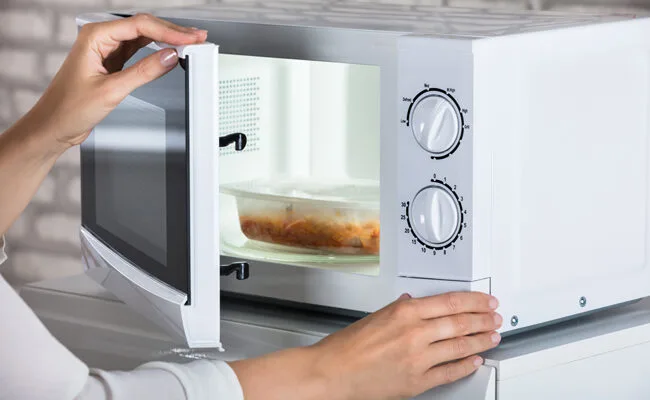
Microwaves are one of the most commonly used cooking equipment. They are used to do a variety of tasks such as heating pre-cooked food, defrosting frozen food, and cooking and reheating leftovers.
By using microwaves you can cook and reheat food. it can also use to do multiple tasks such as cooking pasta, defrosting frozen food, and even making desserts.
However, It is energy efficient, and inexpensive when compared to other cooking equipment.
Types of Microwaves
Low profile microwaves
Over-the-range microwaves
Built-in microwaves
Countertop microwaves
Under-counter microwaves
Convection microwave ovens
Wall oven and microwave combinations
Smart microwaves
Where to place in your kitchen
It can be placed near the preparation area, it will be easier to reheat ingredients or already cooked items during the preparation time.
To quickly and frequently use the microwave for your chefs then it is more convenient to place it near the stove and other cooking equipment. So chefs can simply heat small dishes or liquid ingredients when preparing food.
Some larger restaurants may have a dedicated area for reheating or warming dishes, this area is often known as a “hot box” which is equipped with multiple microwaves and may also have warming shelves and trays.
5. Steamers
It is a common type of equipment used in restaurants to bake, boil and cook food. It consumes fuel such as a gas burner or electric heating element.
Steamers are considered a healthy cooking method as they do not require oil and retain the nutrients and flavors of the food.
The commercial food steamer is used to cook menu items such as rice, vegetables, and shellfish.
6. Rotisseries
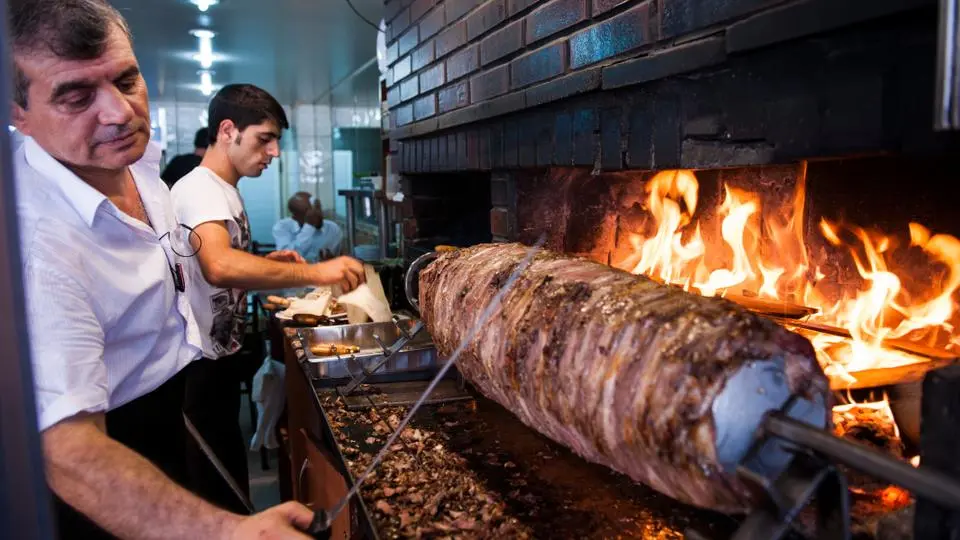
It is also known as spite-roasting. It is used to roast meat by slowly turning it on a spit over a heat source. To produce high heat it fuels gas and electricity. and spite can be rotated manually or with an electric motor.
Types of rotisserie
Horizontal Rotisserie: This particular style of rotisserie includes a spit that is horizontal and runs parallel to the ground. It can cook a whole chicken, and roast various types of meat.
Vertical Rotisserie: This type of rotisserie has spite that runs vertically.
It is important to keep the rotisserie away from flammable materials. and also make sure to place a well-ventilated area
Ranges
Rangers are one of the most used equipments in a restaurant. It can be used to fry, grill, broil, saute, boil, braise, simmer, warm, and even bake.
Refrigeration equipment:

The refrigeration equipment is used in restaurants to keep food and ingredients fresh and at safer temperatures. It can extend the shelf life of a food product.
Foods and ingredients are perishable. To run a profitable restaurant business you could have to keep your food and ingredients safe and fresh. Refrigeration can preserve food items for a certain period.
There are types of refrigeration equipment.
1. Refrigerators
Refrigerators are commonly used equipment in restaurants. It is a large container that usually contains cool inside with the help of electricity. You can adjust the temperature inside the refrigerator.
2. Freezers
The freezer should be 0°F (-18°C) temperature to store food safely. They are typically larger than household freezers and are designed to withstand the heavy use and frequent opening and closing that occurs in a restaurant setting.
3. Ice makers
As its name, it is used to make a large quantity of ice. It is typically larger than household ice makers.
It is important to maintain the ice makers regularly and make sure the producing ice is safe and clean, However, you have to do regular cleaning, checking and adjusting the water and air filters, and ensuring the unit is properly connected to a water source.
Where you can place your Refrigeration equipment
It is important to consider your available space and layout design when placing refrigeration equipment in your kitchen. Most of the refrigeration equipment is physically larger. Corners are best to place it, especially if you have limited space.
Dishwashing equipment:
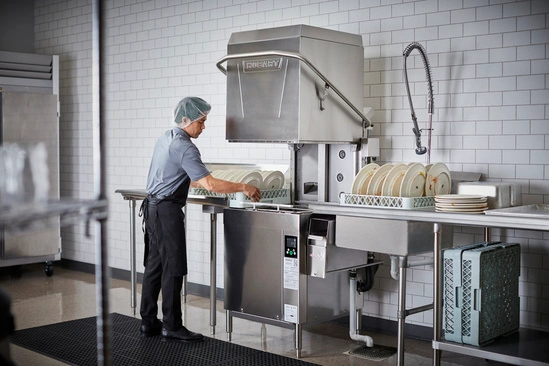
Some restaurants are using separate rooms for placing refrigeration equipment. This will help them keep the equipment at the right temperature. It also allows you to keep free space in your kitchen.
Dishwashing equipment is used to clean and sanitize other kitchen equipment.
Types of dishwashers
1. Dishwashers
A dishwasher is a machine that automatically cleans cutlery, cookware, and dishware. It can be an under-counter or conveyor model.
2. Pre-rinse units
The pre-rinse is dishwashing equipment that consists of a spray nozzle and a sink area. It is used to remove food residue from dishes before washing them in a dishwasher.
3. Glasswashers
Glasswashers can be used to clean and sanitize glass dishes.
Sinks:
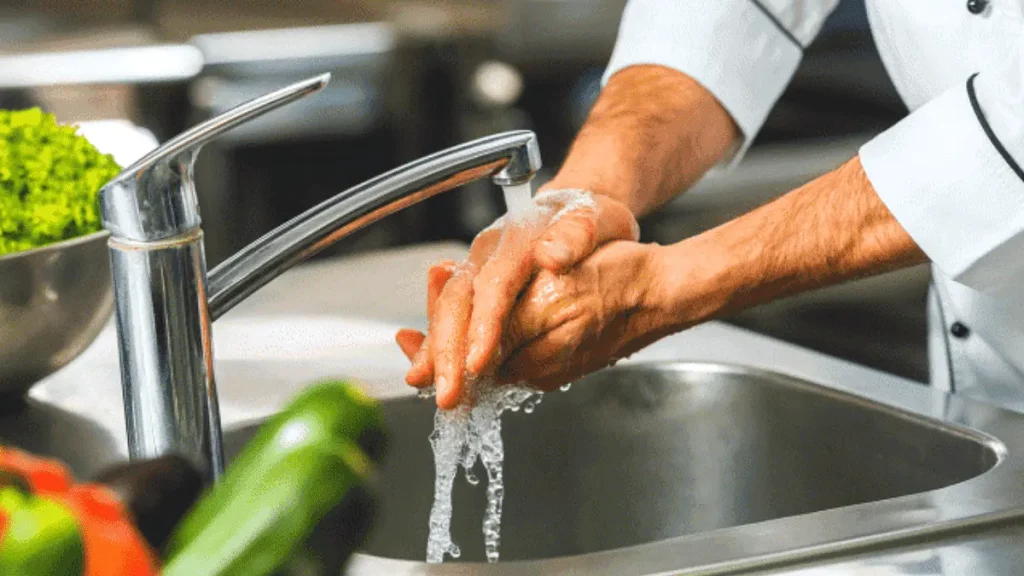
The sink is the equipment used in the kitchen to wash hands, dishes, and utensils. You can set multiple sinks in different places in your restaurant.
There are different types of sinks available for restaurants such as hand sinks, compartment sinks, and bar sinks.
1. Hand sinks: Hand sinks can be placed in easily accessible locations, such as near restrooms and entrances, to ensure that employees and customers can easily use them.
2. Compartment sinks: Make sure there is enough space around the compartment sinks. Compartment sinks can be used by too many people. Also make sure you are placing it near where dishes and utensils are used and stored, to make it easy to wash them.
3. Bar sinks: Bar sinks can be placed at the bar, near where glasses and other bar equipment are used, to make it easy to clean them.
4. Mop sinks: you can place mop sinks in an area that is easily accessible to staff such as a janitorial area or a kitchen
5. Prep sinks: Place prep sinks in the kitchen area, near where food is prepared, to make it easy to wash produce and other ingredients.
6. Utility sinks: the best place to place utility sinks is the kitchen area, near where large pots and pans are washed, to make it easy to sanitize utensils and other equipment.
7. Scullery sink: It can be placed in the kitchen area, near where dishes, pots and pans, and kitchen equipment are cleaned.
Preparation equipment:
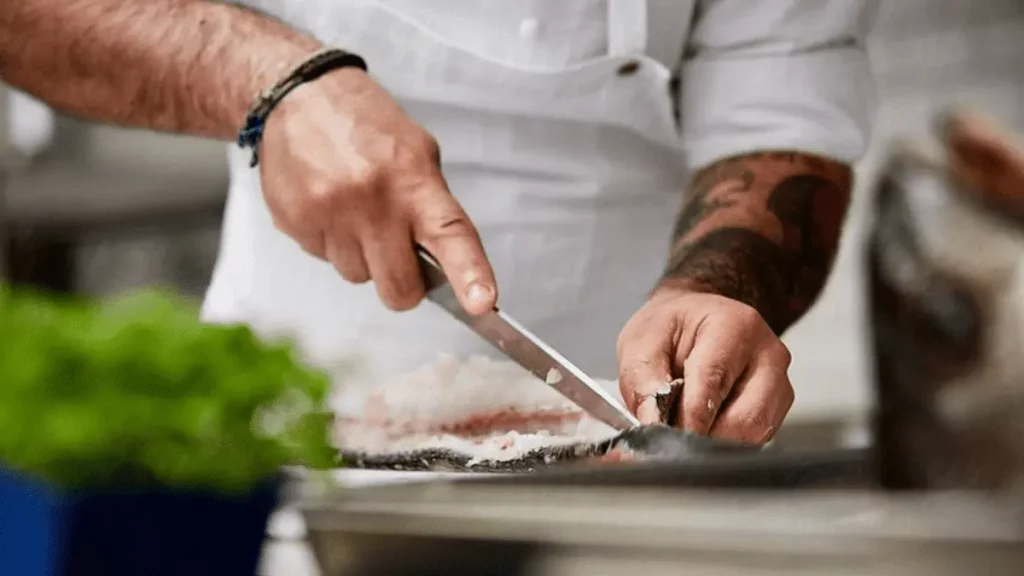
Preparation equipment is one of the pieces of equipment that is used to cook and prepare food.
1. Knives: Used for cutting and chopping ingredients
2. Cutting boards: Used for chopping, dicing, and slicing ingredients
3. Measuring cups and spoons: It is used to measure the volume of solid or liquid cooking ingredients
4. Colander: It is used to dry foods and ingredients such as pasta, and wash vegetables.
5. Vegetable Peeler and potato smasher: The vegetable peeler and potato smasher help speed up your cooking time.
6. Whisk: It is used to whisk foods such as salad dressing and other mixing of food ingredients.
7. Blenders: Blenders are common equipment used by restaurants. It can be used to prepare various types of foods such as juice, smoothies, milkshakes, and cocktails. It is also used for preparing ingredients.
8. Food processors: Used for chopping, grinding, and pureeing ingredients
Serving equipment:
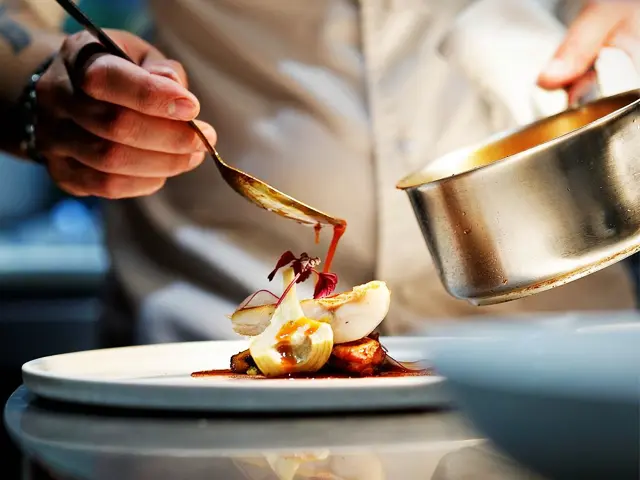
Serving tools and equipment that are used to serve food to customers.
1. Warming trays
2. Chafing dishes
3. Buffet servers
4. Tableware (plates, bowls, cups, glasses, silverware)
5. Serving platters and bowls
6. Serving utensils (tongs, ladles, serving spoons)
7. Chafing dishes and warming trays
8. Beverage dispensers (coffee, tea, juice, etc.)
9. Condiment dispensers (sugar, cream, ketchup, mustard, etc.)
10. Tray stands and tray tables
11. Napkin holders and dispensers
12. Tablecloths, placemats, and coasters
13. Salt and pepper shakers
14. Ice buckets and tongs
15. Juice dispensers, jugs, and carafes
16. Butter dishes
17. Water glasses and jugs
18. Wine glasses and bottles openers
19. Dish racks and carts
20. Bussing tubs
21. Lazy Susan
Storage equipment:
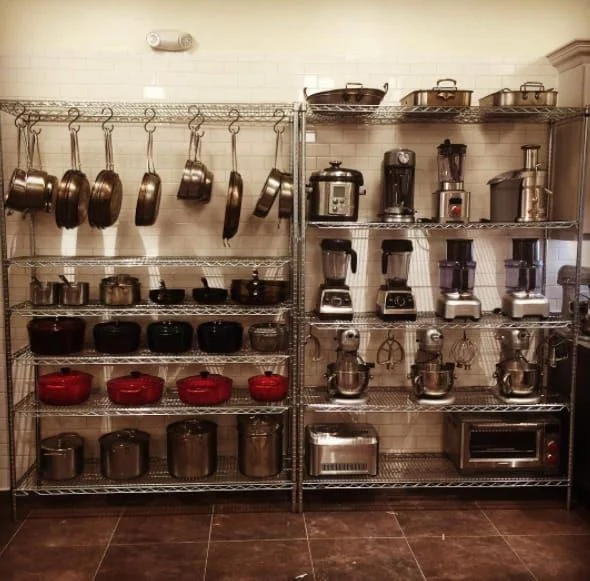
Storage equipment is used to store food and its ingredients. Equipment storage is a critical aspect of running a restaurant, as it helps keep the kitchen organized, safe, and efficient, which in turn helps the restaurant run smoothly and can save money in the long run.
1. Refrigeration units
2. Shelving: Shelving helps you to get more space in your kitchen by organizing the placement of ingredients and other equipment. There are types of shelves available such as corner shelves, Shelves designed to hold canned goods, and over head shelves.
3. Prep tables: A metal rack designed to keep food, mixers, and other food ingredients organized and easily accessible.
4. Frozen storage: Perishable foods such as milk, and meat can be stored in frozen storage.
Dining equipment:
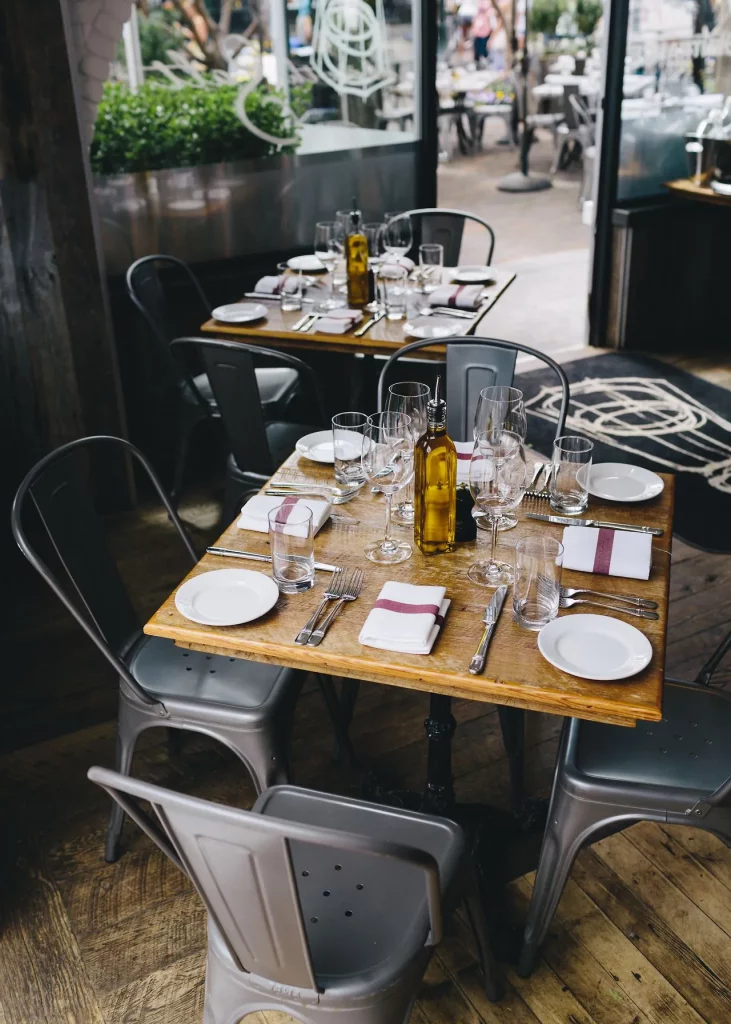
Dining equipment refers to tools and items used to prepare and serve food.
1. Tableware: plates, bowls, cups, glasses, silverware, napkins, and tablecloths
2. Cookware: pots, pans, baking sheets, roasting pans, and casserole dishes
3. Kitchen utensils: tongs, spatulas, ladles, whisks, peelers, and cutting boards
4. Small appliances: toasters, blenders, mixers, and food processors
5. Serving equipment: trays, platters, and serving utensils
6. Buffet equipment: chafing dishes, warming trays, and serving spoons
7. Table service equipment: salt and pepper shakers, sugar caddies, and condiments holders
8. Bar equipment: shakers, strainers, jiggers, and bottle openers
9. Cleaning equipment: mops, brooms, sponges, and cleaning chemicals
10. Furniture: tables, chairs, booths, and bar stools
Safety equipment:
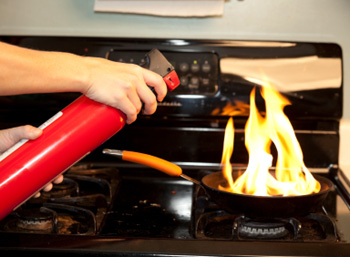
Safety equipment is really important when it comes to the restaurant business. You have to take proper safety precautions to prevent fires, protect against carbon monoxide, provide first aid, prevent slips, protect employee and customer health, comply with regulations, ensure a safe working environment, protect the reputation, and more.
Types of safety equipment used in restaurant
1. Fire extinguishers
2. Smoke detectors
3. Carbon monoxide detectors
4. First aid kits
5. Slip-resistant floor mats
6. Properly labeled emergency exits
7. Personal protective equipment (PPE) for employees, such as gloves and face masks
8. Properly maintained kitchen equipment, such as stoves and ovens
9. Proper storage for cleaning chemicals and other hazardous materials
10. Proper food handling and storage equipment, such as refrigerators and freezers.
Other equipment:
Some equipment in restaurants refers to miscellaneous equipment. It is not directly related to food preparation or service but is still necessary for the operation of the restaurant. Some examples of different equipment in restaurants include:
1. POS systems
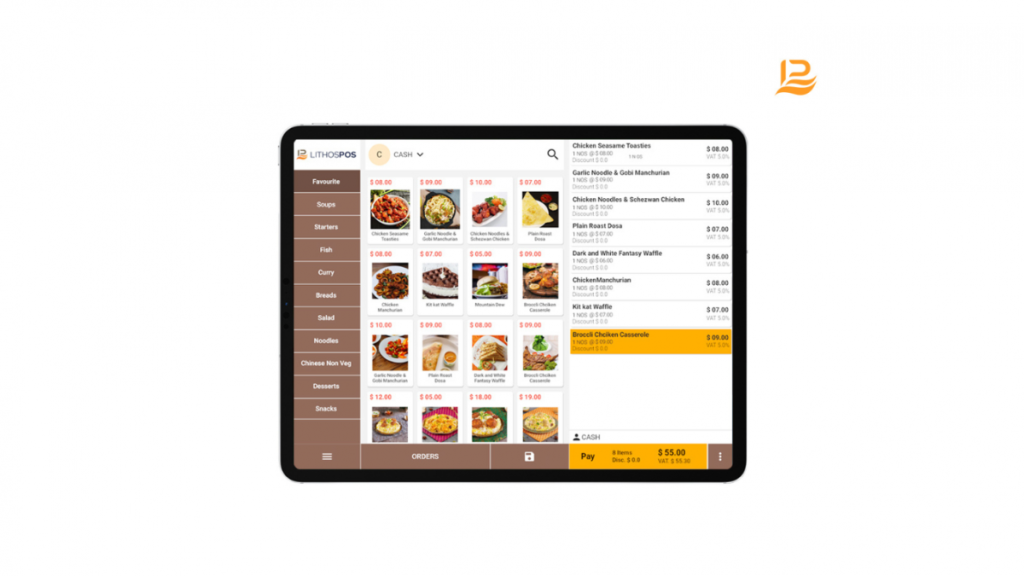
A POS system is a system that is used to record and process sales transactions. It consists of a hardware component, cash drawer, customer display, and a barcode scanner, as well as software that is used to manage and process sales transactions.
The POS system helps businesses to manage sales, customers, employees, payments, and other business operations.
- Recording and managing sales transactions such as items purchased, the total cost of the sale, and the method of payment (cash, credit, debit, etc.)
- The inventory management feature track inventory levels, monitor product sales, and reorder items as needed. It helps you to manage and keep your inventory efficient.
- The financial reporting feature helps you to generate financial reports, such as sales reports, inventory reports, and customer reports.
- You will also easily get real-time, weekly, monthly and yearly reports.
- With a customer, management features POS stores customer information, such as contact details, purchase history, and loyalty program information. You can use the customer data for your loyalty and other marketing programs.
- POS tracks employee performance, such as how long it takes them to process transactions, how many transactions they process, and how accurate their transactions are.
- Integrate with other systems such as accounting software, inventory management systems, online aggregators, e-commerce platforms, and a wide range of payment partners.
- Manage your multi-location businesses and online businesses using POS software. Transfer goods between your stores and keep your business efficient.
After all, the POS system helps you manage and grow your business. By automating the most tedious and difficult manual business operations, you can simplify business operations and focus on business growth.
2. Kitchen display system
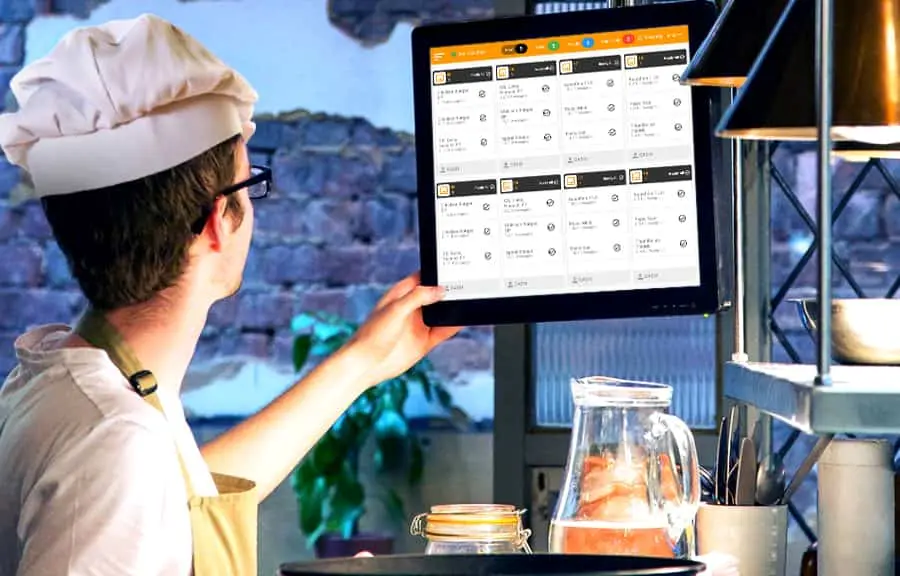
A kitchen display system(KDS) is a computer system that is used in food-related businesses to display and manage orders from the point of sale system to the kitchen.
When an order is placed it is sent to the POS and the kitchen, kitchen staff can see the orders and requirements of the order. Also, he can see the priorities of which order should be prepared first, etc.
However, the kitchen staff can work more efficiently by reducing the time it takes to prepare and deliver orders. Additionally, it can help to improve order accuracy by providing clear and concise information about orders and can help to reduce food waste by ensuring that orders are prepared correctly the first time.
The smart KDS can also have features such as real-time tracking of food preparation and delivery, inventory management, and reporting capabilities, which can help restaurant managers to make more informed decisions about their operations.
3. Cash registers
The cash register is a system that is used to record and calculate transactions at a point of sale. It typically includes a drawer to store cash and a display for showing the total amount.
Cash registers also store sales data, which can be used for financial reporting, inventory management, and other purposes. They also help to prevent errors and fraud by providing a clear record of each transaction.
Cash registers are often replaced by POS (point-of-sale) systems, which have more features when compare to cash registers.
4. Kiosk
A kiosk is a system used in restaurants to order food without the assistance of staff. Customers can see the digital menu and also pay through kiosks. The orders will be transferred to POS and the kitchen.
Kiosk helps you to enhance service quality, order accuracy, and overall premium customer experience.
5. Security cameras
Security cameras are surveillance device that is used to monitor and keep secure a specific area in your restaurant. It is used to deter theft, monitor employee performance, and provide evidence in the event of a crime.
Some common types of security cameras used in restaurants include CCTV (closed-circuit television) cameras, IP (Internet Protocol) cameras, and wireless cameras.
How to maintain your equipment
It is really important that maintain restaurant equipment for your safety and extend its lifespan. Here are some tips to maintain your equipment.
- Read the manufactures instructions and use the equipment properly for long-term usage.
- Regularly clean your equipment.
- Perform regular inspections of the equipment and make sure everything works well.
- Keep equipment lubricated and in good working order. as recommended by the manufacturer, lubricate moving parts, such as gears and bearings. Ensure that all safety devices and guards are in place and functioning properly.
- Schedule regular maintenance and contact a service professional as needed. So this will help you identify and address issues before they become major problems.
- Train all employees on how to properly use and maintain the equipment to prevent damage and prolong the equipment’s lifespan.
Where to buy restaurant equipment
There are several options to buy equipment for your restaurant.
From a local store: Purchasing from local equipment dealers, it is more personalized because they know well about the local market it is more helpful to find the right equipment for your specific needs.
It is also more convenient to install and can quickly replace a broken piece of equipment. They can also provide better service and maintenance when compared to online suppliers.
From online stores: Online store is an option to purchase restaurant equipment. Online sellers like Amazon, Webstaurantstore, and KaTom.
Manufacturer’s websites: You can buy products directly from the manufacturer’s websites. It is an option if you are looking to buy a specific brand or model of equipment.
Secondhand: If you are not going to buy new equipment, you can also buy second-hand equipment. It costs less compared to buying new equipment. Make sure the equipment is in good condition and worth for money.
Compare the equipment of each option and their prices and analyze their reviews before purchasing.
Financing (types of loans, price of equipment)
There are a lot of financial options to purchase restaurant equipment such as Traditional bank loans, leasing, SBA loans, equipment financing, business credit cards, and crowdfunding.
Before going to take financing to purchase you need to consider some key factors.
- The total cost of the equipment and any additional costs such as installation and maintenance.
- The length of the loan and the interest rate.
- The creditworthiness of the business and its ability to repay the loan.
- The loan terms and conditions, such as collateral requirements and prepayment penalties.
It is better to consult with a financial advisor before taking an option.
Types of financial options to purchase restaurant equipment
Traditional bank loans
It is the most common option to fund. It typically involves applying for a loan with a bank or credit union.
Leasing
Leasing is an option to purchase highly expensive equipment. It is a cost-effective way to acquire the equipment your business needs without a large upfront investment.
SBA Loans
Small Business Administration (SBA) loans are government-guaranteed loans that can be used to purchase equipment, as well as for other business expenses.
Business Credit Cards
Some business credit cards offer promotional financing for equipment purchases.
It is really important that you have to consider your financial position before taking loans. Make sure your business can meet the loan and is capable of completing the loan.
Choose equipment for your specific needs
List your restaurant business needs and purchase the necessary equipment. Buying multi-functional equipment and considering the trends in equipment will be cost-effective. You can also consider second handed equipment as it is low cost.

